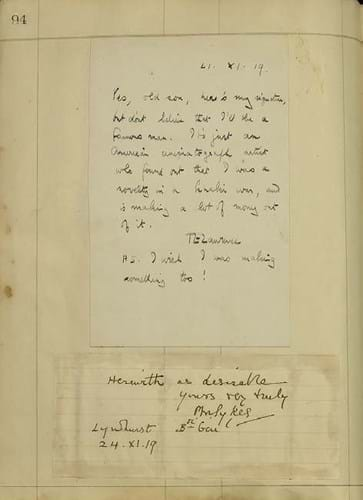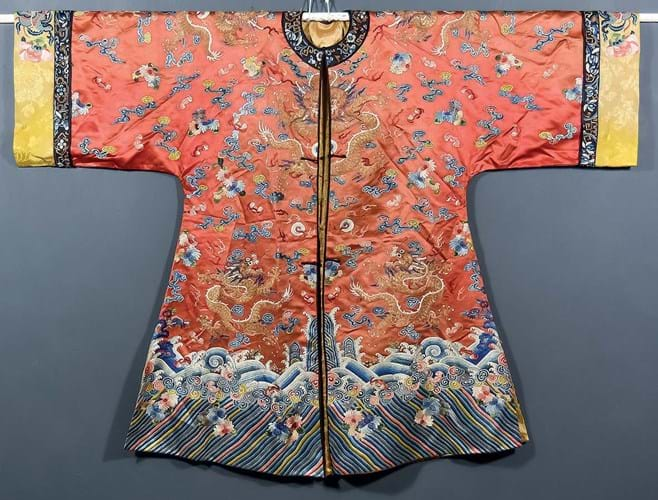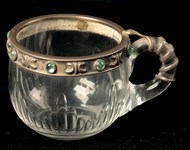It was his rueful comment on his fame and lack of fortune that ensured the album’s prominence at a wideranging 900-lot sale at Canterbury Auction Galleries (22.5% buyer’s premium) on April 1-2.
The boy scout, an Archibald Gibson who lived in Ramsgate, Kent, had sent a polite letter asking for Lawrence’s autograph.
Dated 21 XI 19, the reply read: “Yes, old son, here’s my signature, but don’t believe that I’ll be a famous man. It’s just an American cinematograph artist who found out that I was a novelty in a khaki war and is making a lot of money out of it.” Lawrence added as a postscript: “I wish I was making something too!”
The letter is unusual in that Lawrence signed his real name, TE Lawrence. The auction house noted: “He hated the limelight and later used pseudonyms to hide his identity. He enlisted in the RAF under the name ‘John Hume Ross’ and, later, ‘Thomas Edward Shaw’ – a name he used until his death, accompanied by a ‘TES’ signature.
At the date of the letter, November 21, 1919, he would have been 31 and recently demobbed as a lieutenant colonel.
The auction house added: “Our presumption is that he [Lawrence] was referring to a short film made of him by an American war correspondent, Lowell Thomas, who, along with cameraman Harry Chase, had encountered Lawrence in Palestine, drawn by rumours of his exploits.
“In August 1919, three months before the letter [to the boy scout] was written, Lowell Thomas had launched a series of illustrated lectures in London. Alongside Arabic music and dancing were photos and film of Lawrence, attired in his familiar headdress. The film especially became hugely popular, and we guess this is what Lawrence refers to in the letter.”
In 1927 Lowell Thomas returned for a second photo shoot and edited his work into a longer film With Lawrence of Arabia. It was seen by an estimated 3m people between 1920-24 and made Lawrence a star.
The boy scout chose to title his collection of missives Men who did something [in the war].
He had received replies from other luminaries such as Field Marshal Douglas Haig writing from France, David Lloyd George, Arthur Balfour, Herbert Asquith, Rudyard Kipling, Robert Baden Powell and a number of heroes awarded the Victoria Cross.
Consigned by a distant relative of Gibson, the album went just below hopes at £3800 to a London buyer.
Rie and Coper combo

Stoneware coffee cup and saucer with impressed marks for Lucie Rie and Hans Coper, £840 at Canterbury Auction Galleries.
Top names among the ceramics offered at Canterbury were Lucie Rie and Hans Coper whose impressed marks were on a £840 stoneware coffee cup and saucer, with oatmeal, manganese glaze and fine sgraffito lines. It had been estimated at £600-800.
Furniture was led by a c.1850 pollard oak partners’ desk stamped Gillow to the central drawer which made £2700.
Among the watches, an 18ct gold-cased moon-phase by Patek Phillipe, complete with box and all original papers, as expected, led the day at £12,500.
However, of more interest to collectors of earlier watches was 19th century silver pair-cased pocket watch with a movement inscribed for Charles Frodsham & Co, and the serial number 05329. Enamelled to the dial with a town harbour scene and cast and chased to the outer case with an allegory of Peace watched over by Britannia, it made £740.
Half a dozen late 19th and early 20th century Chinese silk items were consigned by the grandchild of Lady Cunningham-Graham whose husband, Admiral Sir Angus, was senior naval officer on the West River in the 1930s.
Best-seller was a robe in coloured silks and gold thread featuring dragons, bats, floral sprays and rolling waves. Pitched at £500-700, it sold to an internet bidder at £2500.
















